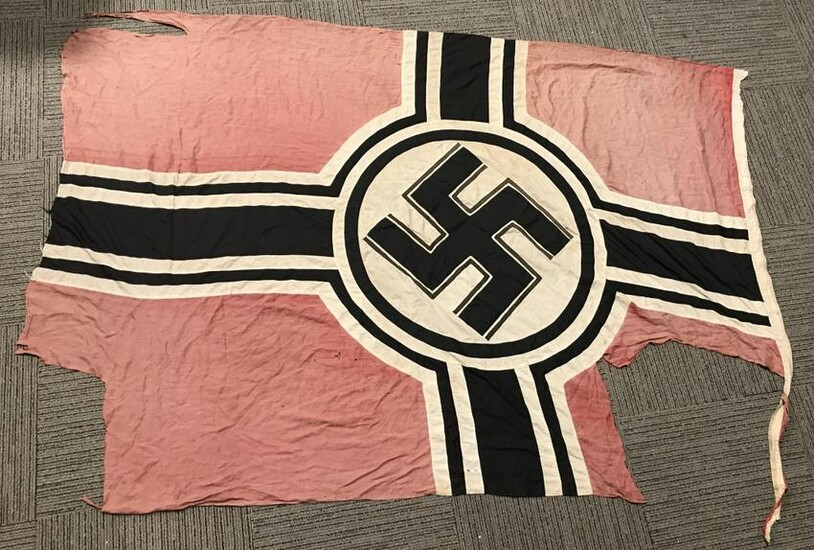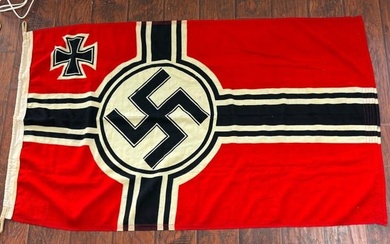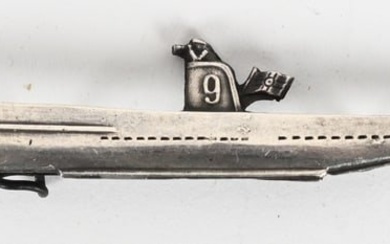WWII NAZI GERMAN KRIEGSMARINE FLAG w/ HISTORY WW2
This flag was brought back by Staff Sergeant Orton C. Misel Jr. of Company D. 329th Infantry, 83rd Division. ASN 35590591 and was captured at the Citadel at St. Servan. During fighting in late August and early September 1944, the historic walled city of Saint-Malo was almost totally destroyed by American shelling and bombing as well as British naval gunfire. The beaches of nearby Dinard had been heavily fortified against possible Allied commando raids. Artillery at the two locations provided mutual support. The fortification complex was garrisoned by more than twelve thousand German troops from different services and units as well as stragglers from other battles in the Cotentin. About eight thousand Germans were in Saint-Malo itself when the battle began. Colonel Andreas von Aulock, the German commander, refused to surrender when asked to do so by the town's authorities. He said he "would defend St. Malo to the last man even if the last man had to be himself". The first American attack was launched by the 83rd Infantry Division on 5 August 1944. German positions at Chateauneuf quickly fell. Cancale was abandoned and occupied by the Americans on the 6th. In the same way and on the same day, Dinan fell to Free French forces. The Germans shortened their lines and drew closer to the ancient citadel at St. Servan-sur-Mer, now reinforced with concrete. Effective German artillery emplacements on the island of Cezembre were out of reach of American ground forces. German garrisons on the Channel Islands of Jersey, Guernsey, and Alderney were able to use small craft to bring in water and remove the wounded from the battle. On 13 August, the walled city was on fire and a short truce was declared to allow French civilians to flee the city. Outlying German positions at St. Ideuc and La Varde fell to infantry attacks. This fighting ended resistance on the north shore of the peninsula. Only the citadel remained. Surrounded by American artillery and under frequent air attack, this last holdout surrendered on the afternoon of 17 August. Cezembre surrendered on 2 September when the three-hundred-man garrison ran out of drinking water. The Americans had taken more than ten thousand prisoners during the two-week fight, von Aulock among them. This Kriegsmarine flag shows obvious heavy signs of wear but it still has a lot going for it. Such as hardly seldom encountered multi piece construction and being completely sewn verses being a printed flag. On the outside band of the swastika is a thinker and slightly metallic bullion thread to really make it stand out. Also with the listing is a hand written note that S/Sgt. Misel wrote about where he captured the flag. The note reads as followed "This 6x9 German Flag was taken from a military headquarters at the waters edge in St. Servan Aug. 13 1944 during the seige of the Citadel. Action described on page 44 of the 329th book". Good. The first modern German war flag was introduced by Kaiser Wilhelm I in July 1867. The war flag went through a number of minor modifications through the years until it reached its final design format in September 1903. The 1903 version of the Kaiserliche Kriegsflagge, (Imperial War Flag), was utilized until it was abolished after Germany’s defeat in WWI on September 27TH 1919. On April 11TH 1921 a new national war flag was introduced that utilized Hohenzollern Empire tri-colors of black, white and red, with the Weimar era, (Circa 1919-1933), national tri-colors of black, red, and gold inserted into the canton, (upper left corner), with a black Iron Cross to the center. In March 1933, shortly after Hitler gained power, he abolished the Weimar era canton insert on the national war flag. The 1933 pattern national war flag was utilized until November 7TH 1935 when Hitler introduced a new, totally redesigned, national war flag that incorporated the NSDAP’s, Nationalsozialistische Deutsche Arbeiterpartei, (National Socialist German Worker’s Party), swastika emblem. Of Note: The 1935 pattern national war flag was utilized until late 1937 or early 1938, when a slightly modified second pattern flag was introduced. The national war flag was flown on all Kriegsmarine, (Navy), warships, Luftwaffe, (Air Force), airfields and all buildings owned by the Wehrmacht, (Armed Forces). The flag was also to be hoisted daily at all occupied barracks and was also utilized at victory parades and special events along with the standard national swastika flag. This example is the second pattern War Flag, circa 1937/38-1945.
[ translate ]View it on
Sale price
Estimate
Time, Location
Auction House
This flag was brought back by Staff Sergeant Orton C. Misel Jr. of Company D. 329th Infantry, 83rd Division. ASN 35590591 and was captured at the Citadel at St. Servan. During fighting in late August and early September 1944, the historic walled city of Saint-Malo was almost totally destroyed by American shelling and bombing as well as British naval gunfire. The beaches of nearby Dinard had been heavily fortified against possible Allied commando raids. Artillery at the two locations provided mutual support. The fortification complex was garrisoned by more than twelve thousand German troops from different services and units as well as stragglers from other battles in the Cotentin. About eight thousand Germans were in Saint-Malo itself when the battle began. Colonel Andreas von Aulock, the German commander, refused to surrender when asked to do so by the town's authorities. He said he "would defend St. Malo to the last man even if the last man had to be himself". The first American attack was launched by the 83rd Infantry Division on 5 August 1944. German positions at Chateauneuf quickly fell. Cancale was abandoned and occupied by the Americans on the 6th. In the same way and on the same day, Dinan fell to Free French forces. The Germans shortened their lines and drew closer to the ancient citadel at St. Servan-sur-Mer, now reinforced with concrete. Effective German artillery emplacements on the island of Cezembre were out of reach of American ground forces. German garrisons on the Channel Islands of Jersey, Guernsey, and Alderney were able to use small craft to bring in water and remove the wounded from the battle. On 13 August, the walled city was on fire and a short truce was declared to allow French civilians to flee the city. Outlying German positions at St. Ideuc and La Varde fell to infantry attacks. This fighting ended resistance on the north shore of the peninsula. Only the citadel remained. Surrounded by American artillery and under frequent air attack, this last holdout surrendered on the afternoon of 17 August. Cezembre surrendered on 2 September when the three-hundred-man garrison ran out of drinking water. The Americans had taken more than ten thousand prisoners during the two-week fight, von Aulock among them. This Kriegsmarine flag shows obvious heavy signs of wear but it still has a lot going for it. Such as hardly seldom encountered multi piece construction and being completely sewn verses being a printed flag. On the outside band of the swastika is a thinker and slightly metallic bullion thread to really make it stand out. Also with the listing is a hand written note that S/Sgt. Misel wrote about where he captured the flag. The note reads as followed "This 6x9 German Flag was taken from a military headquarters at the waters edge in St. Servan Aug. 13 1944 during the seige of the Citadel. Action described on page 44 of the 329th book". Good. The first modern German war flag was introduced by Kaiser Wilhelm I in July 1867. The war flag went through a number of minor modifications through the years until it reached its final design format in September 1903. The 1903 version of the Kaiserliche Kriegsflagge, (Imperial War Flag), was utilized until it was abolished after Germany’s defeat in WWI on September 27TH 1919. On April 11TH 1921 a new national war flag was introduced that utilized Hohenzollern Empire tri-colors of black, white and red, with the Weimar era, (Circa 1919-1933), national tri-colors of black, red, and gold inserted into the canton, (upper left corner), with a black Iron Cross to the center. In March 1933, shortly after Hitler gained power, he abolished the Weimar era canton insert on the national war flag. The 1933 pattern national war flag was utilized until November 7TH 1935 when Hitler introduced a new, totally redesigned, national war flag that incorporated the NSDAP’s, Nationalsozialistische Deutsche Arbeiterpartei, (National Socialist German Worker’s Party), swastika emblem. Of Note: The 1935 pattern national war flag was utilized until late 1937 or early 1938, when a slightly modified second pattern flag was introduced. The national war flag was flown on all Kriegsmarine, (Navy), warships, Luftwaffe, (Air Force), airfields and all buildings owned by the Wehrmacht, (Armed Forces). The flag was also to be hoisted daily at all occupied barracks and was also utilized at victory parades and special events along with the standard national swastika flag. This example is the second pattern War Flag, circa 1937/38-1945.
[ translate ]






